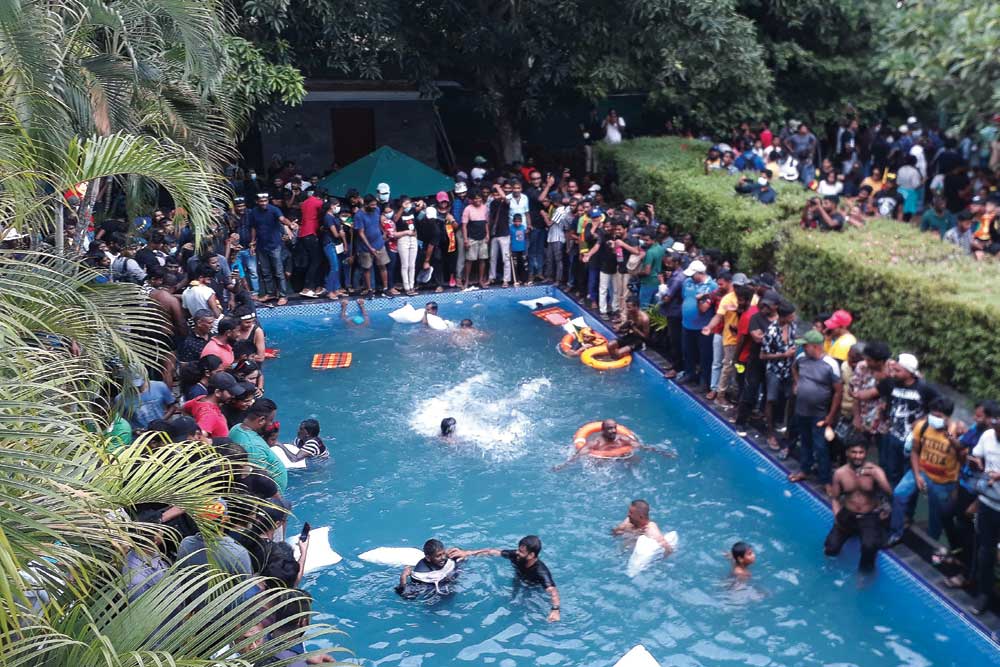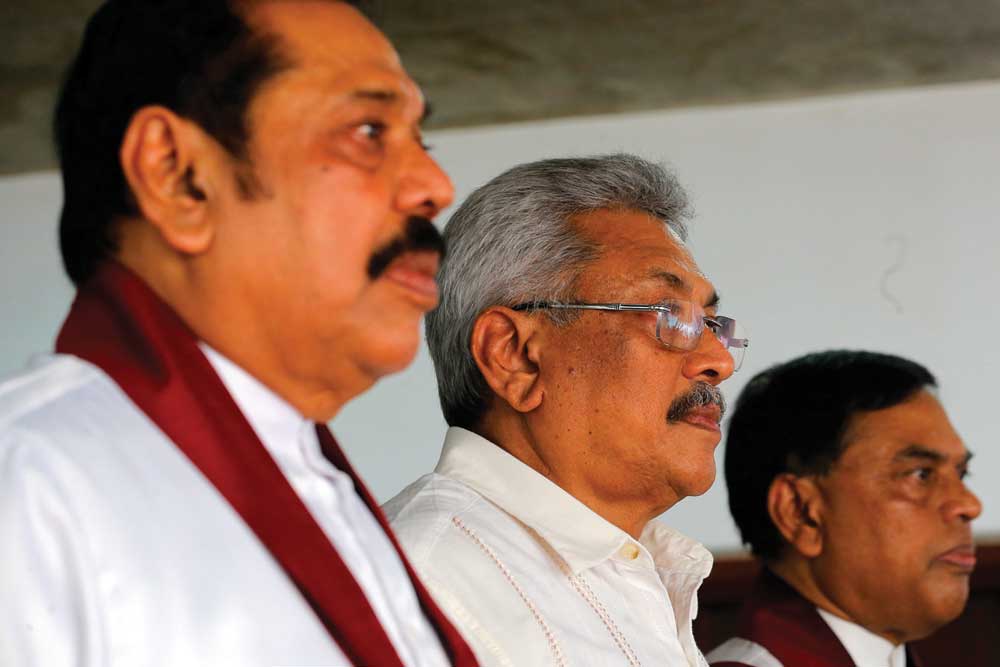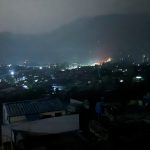The Colombo Spring
When a largely leaderless protest almost broke the back of Sri Lanka’s power elite
 Sasanka Perera
Sasanka Perera
 Sasanka Perera
|
15 Jul, 2022
Sasanka Perera
|
15 Jul, 2022
/wp-content/uploads/2022/07/ColomboSpring1.jpg)
MAY 11, 2022: A vandalised bust of DA Rajapaksa, father of Mahinda and Gotabaya Rajapaksa, at a museum in Weeraketiya (Photo: Reuters)
ON JULY 9 MORNING, the usually pleasurable 19-kilometre and 30-minute drive from my home to Colombo’s Galle Face Green, the site of the main anti-government agitation, had become a challenge. My car had no petrol like many others and on government directives, the Indian Oil Corporation, the only company that still issued fuel, although in very long queues, had stopped the distribution of fuel altogether until July 11. There were no regular buses and hardly any private vehicles in the streets that morning and not too many people either. But given the importance of the date, called by Lankan protesters as the final day to push President Gotabaya Rajapaksa out of office, I decided to walk to the site, stay the night, and walk back the next day. But the protest dynamics have conjured Lankan kindness in different ways as it had done often in times of crisis before. Seeing my resolve on social media, a former student and lawyer, also on his way to the protest with his last litre of petrol on his motorcycle, offered me a ride. We rode through empty streets and were very disappointed that the call for protest had seemingly fallen on deaf ears. We knew people were tired of the deprivations they faced on a day-to-day basis, even as they were also very angry. But we had hoped they would be angry enough to come out into the streets and to the protest site rather than be dictated by the weariness caused by their existential dilemmas and anxieties about personal safety. When we reached Galle Face Green at 9.15AM, while there was a crowd, it was a modest number, hardly capable of creating the kind of powerful visual message that was needed to force out an authoritarian president incapable of recognising his failures and reluctant to leave, and an untrustworthy prime minister without a people’s mandate who was equally reluctant to let go of power.
But the relatively paltry crowd that morning was deceptive and could be easily explained as the short-term effect of government efforts at curtailing the protest. The inspector general of police (IGP) had imposed a so-called “police curfew” from 9.00PM the previous night until further notice, covering most parts of Colombo, trying to ensure people would not congregate on the city the next day. The illegality of the curfew was flagged by the Bar Association of Sri Lanka within hours of its declaration. The curfew came because police efforts through the courts to prohibit people from entering crucial parts of Colombo had already been blocked by the judiciary over the previous days. The courts’ position was that, as long as the protests were non-violent, protesters had the right to protest. The Human Rights Commission of Sri Lanka also warned the IGP of the illegality of the curfew. As a result, it was promptly lifted the next morning. But it had created some anxiety and dampened the mood, particularly among suburban people in the short term, which had delayed them from getting out into the streets. But the unavailability of fuel and regular public transport was a more debilitating factor.

The government had succeeded in ensuring that railway services were illegally stalled, ensuring in turn that people could not be transported to Colombo from the provinces. But all these efforts had fizzled out within hours. Thousands of people who had gathered at main train stations in cities such as Kandy, Galle, Matara and Anuradhapura forced railway authorities to run the trains to Colombo, though behind schedule. In reality, each train turned out to be a protest train not only by transporting protesters but also because the mood on the trains had visibly changed going by the placards people carried, their mostly black attire, and the pro-protest banners affixed to the locomotives. Particularly, this act of ‘commandeering’ the trains by the people ensured that after 11.30AM, and more clearly after 2.00PM, large numbers of vociferous people carrying placards, black flags and national flags were able to reach Colombo from across the country and chanting the slogan “Gota, you tried to stop us from coming to Colombo, but we came anyway.” Soon, with this initial influx, many others also began arriving on private busses whose owners were willing to drive them to the protest site; and on delivery trucks and private vehicles when strangers offered rides to others. Many thousands simply walked and/or rode bicycles. The atmosphere at Galle Face Green had changed completely by early afternoon, indicating this would be a day of reckoning not just for the regime but for Lankan politics in general. Beyond Galle Face, almost in every major town there were well-attended regional agitations and marches taking place at the same time. This was very clearly a national mobilisation on a scale not seen before.
The protesters at Galle Face had been previously described by the government and its supporters as “lawless elements” having an extended “beach party”. In real terms, these were ordinary but agitated citizens, most of whom were not even driven by a clearly defined political ideology. Many were also previously supporters of the president and his government as well as the prime minister. As one of them posted on Facebook, “I made a mistake in voting for the President. I am going to take my vote back.” It was evident that morning that the people congregating on Galle Face had come from across ethno-religious, class, regional and language barriers. This was Sri Lanka across the board fed up with unbearable and unending deprivations and continuous incompetence in governance. Nearly 20 people had already died in fuel and cooking gas queues in the country and till date, there is no indication these lines will end anytime soon. Others, including me, have shifted to cooking with firewood. Some children and older patients have died due to lack of basic medicines, and surgeries had been postponed in the public healthcare system due to lack of medicine and equipment. People became afraid of pets and stray dogs as the country had run out of its stocks of anti-rabies shots. Essential food items had become either unavailable or unaffordable for many and school and university sessions have been disrupted. Thousands of people became unemployed or underemployed almost overnight while their savings dwindled. And in the midst of all this, no politician could be seen in public, including the president. When they made public pronouncements with reference to fuel shipments and the state of the nation, they sounded extremely unreliable.
It was a culmination of these conditions that had driven people to Galle Face Green that morning rather than any ideology. But at least in the short term, these conditions have brought Lankans together as a people with a strongly felt urge to change the system and with the resolve to remove the culprits who brought them to this situation. The loud demand for the president and the prime minister to resign was merely the outpouring of emotions created by these conditions, unfolding in a situation wherein most people felt neither the president nor the prime minister, nor the government they led for that matter, was capable of finding tangible solutions to the problems they faced daily. But it is truly unfortunate that the establishment was incapable of understanding the bitter and desperate mood in the streets and the clear writing on the walls all along. Parliament itself had become an inconsequential space where nothing was resolved despite endless debate on the part of supposedly people’s representatives in whom most citizens had lost faith. There was hardly any publicly articulated sympathy for the privations ordinary citizens faced while the political elites were provided with scarce commodities, such as fuel and electricity, without disruption that were denied to others.

Before the sun had set on July 9, three bastions of political power had literally fallen in Colombo which carried considerable political and symbolic significance. Many people known to me in Lanka and India compared what was happening in Colombo to the fall of the Bastille in Paris on July 14, 1789. The mostly young protesters stormed President’s House, the official residence of the president, through relentless teargas and water cannon attacks as well as limited shooting with live rounds, and ultimately managed to overrun and occupy it despite a heavy military presence on the premises. The president had already fled with his family and close aides the day before and given refuge at an undisclosed location. This unceremonious and surreptitious exit marked a sad turn of events for a president who had campaigned only three years ago as a “war hero” and a “doer” who had won Lanka’s civil war. In the 2019 presidential election, he had won 6,924,255 votes, or 52.25 per cent of the popular vote. He had won the presidency and then amended the constitution to make his already substantial powers as executive president even more daunting. But all that now seems like a distant and short-lived dream, but with catastrophic consequences for the country.
AS NEWS OF THE occupation of the president’s residence spread on TV and social media as well as across messaging services, the next to fall was the Presidential Secretariat, the office of the president. Since protesters had camped across the main entrance of the complex over the last three months, the president had not been able to use his own office during that time. Over the last three months, he had been working out of a temporary office at President’s House. Soon after, the Temple Trees, the official residence of the prime minister, was also occupied by the protesters.
Protesters occupying the sidewalk across the main entrance of Temple Trees had called their camp “No Deal Gama” (or No Deal Village)—a reference to the political deals and horse-trading Prime Minister Ranil Wickremesinghe had become well known for all through his career as well as in the recent past when he managed to become prime minister without a single seat in parliament won by popular vote.
In symbolic and political terms, these occupations signalled the falling of a despised political system at the height of its power. It had by then lost the public trust almost completely and was marred by credible allegations of corruption and mismanagement on governance and the economy. It also marked the vague emergence of a vastly different order led by the protesters. That new order was represented by a sense of idealism and, so far, mostly non-violent political action.
To have a future worth living, Sri Lanka will need to root out its endemic corruption. This should include electoral reforms as well as ensuring that those responsible for the debacle are legally dealt with
In the context of these momentous changes, an emergency meeting of all parties represented in parliament was held at Speaker’s Residence (the official residence of the speaker of the Sri Lankan parliament) on July 9 itself as these historic events were taking place. The unanimous decisions at this meeting were that the president and the prime minister would resign immediately, an interim all-party government would be installed, an acting president would be appointed and fresh elections called within a specific period. Constitutionally, if the Lankan president resigns, only the prime minister, the speaker of parliament or the chief justice can be appointed as acting president. The speaker communicated these decisions by letter quickly and formally to the president that evening, and the president indicated from his hideout that he would resign on July 13. In this communication from the speaker, an alternative suggestion was included at the insistence of the prime minster. That is, for the president to resign immediately as well as for the prime minister to be appointed acting president and for him to then appoint a new prime minister and form an interim all-party government. It is truly mind-boggling that the prime minister could even think of including such an alternative, indicating clearly that he was oblivious to the fact that he had no popular mandate or even a sense of tangible trust across the country. He also seemed lost to the fact even at this late stage that one major factor that had fast-forwarded what happened was his own lack of credibility and standing in the country.
While the president fled the country to the Maldives aboard a Sri Lanka Air Force troop transport in the morning of July 13, his resignation letter had still not been made public. In fact, the speaker is on record in an interview with Colombo’s Hiru TV for saying that he had received no such letter as of the morning of July 13.
The protesters who still occupied the three political sites made it very clear that they would not relent or leave until the resignations of the prime minister and the president were officially announced and an interim all-party government formed which would also adhere to a system of consultations with them. However, only an initial and inconclusive meeting with some of the protest leaders and members of parliament has happened so far. The protesters, for their part, issued a six-point set of demands from the occupied President’s House in the evening of July 9: in addition to the resignation of the president and the prime minister, they also demanded the resignation of the entire government, including ministers, advisers, secretaries to ministries, and heads of statutory bodies; the appointment of an interim government sensitive to the wishes and demands of the protesters, with a legally binding link to the representatives of the struggle; implementation of a short-term emergency aid programme to alleviate the difficulties faced by the people in the present economic conditions; introduction of a new people-centric constitution; getting this constitution approved by a direct referendum; and that the interim government should come to an end in a maximum period of 12 months, and that its only purpose would be to implement the conditions outlined in the protesters’ six-point plan of action.
Going through the entire document written in the Sinhala language, it is clear that it has been formulated with a self-conscious idealistic social justice agenda in mind. This is a reasonable point of departure because it shows a clear intention to change the existing faulty and largely corrupt political system. Also, whether one likes it or not, this is a matter of democracy at work. These are citizens stating that they have no confidence in the government they elected and demanding a system that would work. But more than a short-term agenda, what is needed is a long-term plan to make such wide-ranging changes possible. However, something this idealistic is needed as the foundation if Sri Lanka is to forge its future as a free society. The immediate challenge is to see how representatives of the present parliament, who necessarily will have to be part of the proposed interim administration, will respond to a plan that will ideally put an end to the system they are so used to, have immensely benefited from, and are an integral part of. But this is a necessity. To have a future that is worth living, Lanka will need to root out its endemic corruption at all levels. This needs to necessarily include radical electoral reforms as a long-term measure as well as ensuring that members of the regime and opposition, as well as officials responsible for the recent debacle, are legally dealt with and the funds illegally amassed by the Rajapaksas and their political cohorts recovered. Without ensuring this, the confidence in the new system envisaged by the young protesters who led the people’s uprising in Lanka cannot be instilled or a long-term foundation for a decent future laid. Symbolic of the unresolved future, queues of vehicles still stand mute at fuel stations across the country without their owners until better news reaches them.
What is clear is this: however Sri Lanka decides to reinvent itself in times to come, its prevailing pains are not going to end soon. But in the very least, purely by the power of the people, and that too without violence, Lankans have cried out loudly that “enough is enough” and have begun to map out their future. In the process, the protesters have outsmarted the main culprits despite the power they wield. It would be a mistake if South Asia’s political leaders and thinkers considered the Lankan experience a mere local anomaly and did not make serious attempts to study what has happened in the country. That is because, as far as social movements go, a large, popular, mostly leaderless and non-violent, popular movement is not simply a local idiosyncrasy but a phenomenon that has regional potential and applicability in similar socio-political conditions.

/wp-content/uploads/2025/05/Cover-War-Shock-1.jpg)












More Columns
A Trump Shock To The Pharma World Open
Social Media As an Echo Chamber Nandini Nair
Seventy-two Hours That Changed South Asia VK Shashikumar